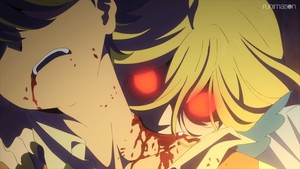The Case Study of Vanitas
Episode 5
by Rebecca Silverman,
How would you rate episode 5 of
The Case Study of Vanitas ?
Community score: 4.3

Let's get this out of the way first: the fifth episode of The Case Study of Vanitas is preceded by a content warning from Funimation. That at first seems a little silly – after all, it's a series about vampires, so violence is, to a degree, understood to be part of the deal, plus last week's episode featured a pretty gory “meal” by Jeanne. So what's with the warning? The reason, it turns out, is that this time the violence is perpetrated by and on children, and yes, it is pretty unsettling. Up to this point we've fairly strictly seen acts of death and gore only when they involve people who at least look adult, so having children be part of it could be difficult, if not a deal breaker, for some viewers. Do I think it's strictly necessary? Not really, but I also believe that no one should be taken by surprise by a trigger, because we watch anime for fun, not to have old wounds reopened.
To be honest, I have a much harder time with aural triggers, and parts of the screaming this week were uncomfortable for me. That balanced out (for me) with the visual nods to the French Revolution that also came with it. By my reckoning, that looks to be roughly one hundred years prior to the main action of the show, and it still eclipses almost any other French military engagement in popular imagination, excluding the French Resistance during WWII. Those images, therefore, proved very effective, even if you didn't catch all of them. The main one, of course, is Louis' bloodied head lying on the ground, having been severed from his body by “Teacher.” The gouts of blood on his cheeks, the half-open eyes, the disordered short hair…all of it could have been taken from an engraving of royal and aristocratic heads after their owners met with Madame la Guillotine. Noé's expression as he stares at it likely mimics the shock and horror of some of the observers as well. That's what makes the second major visual reference so effective: when Charlatan (or the sooty ghost currently representing Charlatan) is going in for what looks like the world's worst kiss, we see that Noé is no longer in his costume, but dressed all in white. Since victims of the Terror were often pulled from bed or deprived of their expensive outer wear prior (or after) incarceration, they often went to the guillotine wearing white – the color of most undergarments and nightgowns of the time. Noé's white outfit, therefore, is shorthand for his precarious situation: he's on the verge of execution himself.
That it would be a very different one from Louis' is another interesting element. Although Louis doesn't physically die until the end of the episode, he could be said to have been dying by inches for most of it. Louis knows that his family has, for reasons he doesn't entirely understand, thrown him aside. He knows that it's technically because he's a curse-bearer, but he doesn't know what that really means. About all he realizes is that he is doomed to die the moment he loses control, and from the moment he discusses it with the blond man, he begins preparing himself for death. Carving a box full of stakes is probably even more upsetting than the violence, because from the minute we first see him carving, we know that this is a child getting ready to die – possibly by his own hand.
With all of this revealed, it's easy to hypothesize that Dominique wears masculine clothing to try and fill both her own place and that of her brother, and it's also frankly shocking that Noé is as emotionally stable as he is. How Vanitas balances that out feels like part of the series' long game, but I do think they're likely two sides of the same coin in terms of their feelings and reactions to the curse bearers. (Vanitas is clearly more self-destructive, although he seems none the worse for his encounter with Jeanne's fangs.) Braham Stoker's Dracula may be having more of an influence than we at first might have assumed, too, as the name of one of Domi and Noé's childhood friends is Mina and the stakes are clear representations of traditional Stoker-esque vampire lore.
And because you're probably expecting it, yes, Mina's Victorian undies are more period-correct than we typically get in anime, although her drawers (bloomers) probably would have had an open crotch. Domi's mourning dress is also more historically accurate than not, and on the whole this show is doing a great job with that sort of period detail, from underwear to actual legible French whenever text appears onscreen. No Dairy Londner here, and in my opinion, The Case Study of Vanitas is the better for it.
Rating:
The Case Study of Vanitas is currently streaming on Funimation.
discuss this in the forum (49 posts) |
back to The Case Study of Vanitas
Episode Review homepage / archives